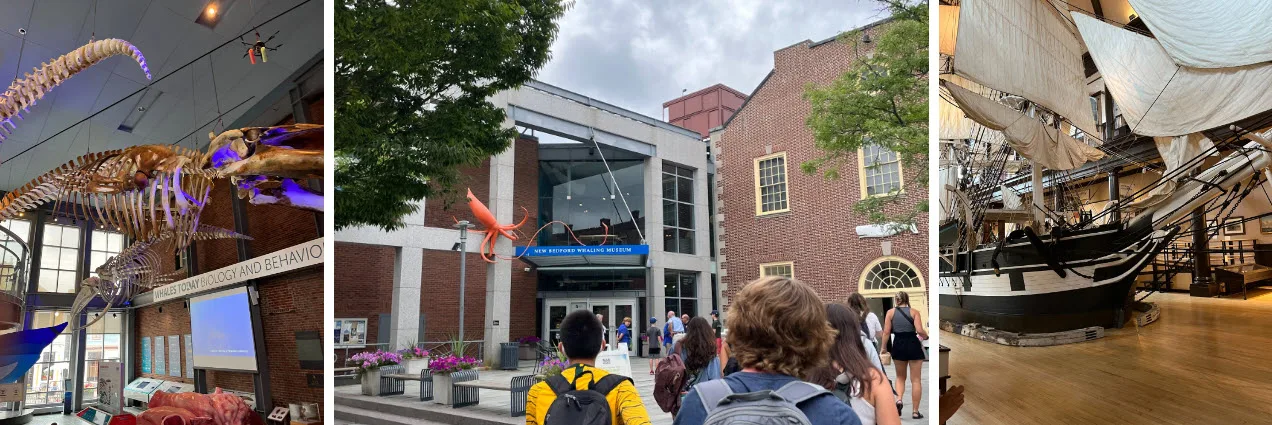Programs Blog
New Bedford Whaling Museum Day Out

By Harper Greenfield Oakwood Secondary School and Jimmy Shen Culver Academy
Today we had an early start to our day with a quick breakfast at the picnic tables. A bus promptly pulled up to campus, and we were taken down to the museum. The ride was around forty-five minutes giving those who were still tired from the early wakeup, some time to rest our heads. We were met by Ben, our Oceans and Society teacher, right in front of the museum and were split up into three groups led by museum guides.
The guide first took us to the colonial area, which briefly talks about the history of trading and colonialism in New Bedford. This area contains information about how Europeans learned the currents for locals and convinced them to sell this land to Europeans. The guide brought us to the figure of Barthlomew Gosnold, the first Europeans who traded with local citizens in New Bedford.
Then, the guide took us to the area of Captain Paul Cuffe. Captain Paul Cuffe was one of the famous black captains at that time. He is the first color who got invited to white house as a guest. He was black and half natives. He was also an abolitionist in the 19th century by offering jobs of crew members for black people. The guide also mentioned that in the 19th century, Quakers who lived in New Bedford provided job for some slaveries as they believe everyone has the rights to live in the light.
The guide then took us to a tall room covered with artifacts found on and off the ships of their time. Big, looming windows were cast over the cases, bringing life into these now dusty objects. In the center of the room sat a model of one of the most prosperous whaling ships of all time. This very ship that we saw is the largest known model of any whaling ship ever kept in a museum. We were led onto the ship, and learned about the process of breaking down the whales bodies after they were caught and brought to the deck of the ship.
During this process, the whale would be hung from a designated hook and stripped by hand by the crew. Once pieces of blubber and internal organs were separated from the whale’s tough skin, the whale’s insides would steep in these tripods above a large fire. The meat from the animal would produce an oil and once extracted and collected, the leftover meat would be shoveled into the flames to keep the fire burning. This process was vigorous and took time and effort from everybody working on these ships. To catch the whale and bring it to the ship was a whole other story…
To catch these whales, six men at a time would squeeze into these small boats located on the sides of the main body of the boat. Once a whale was spotted, and the boats lowered, the men would row out to the whale with huge wooden oars and stab it with a harpoon attached to the small boat.
The whale would then drag the small boat around in circles for hours, this was commonly known as a Nantucket Slayride. Once the whale would tire out and stop moving, the crew would wait in hopes for their boat to pick them up and take the whale on deck. Men would wait for hours hoping for their boats to return, wishing that they weren’t forever lost at sea.
At the end of the day, we had gathered around the fire to hear some of the local stories from a formal storyteller Jenny. We ended our day by hearing some of the stories that are related to witches.
Recent Posts from the Ships
- Ocean Classroom 2024-A collaborative high school program with Proctor Academy
- Collaborations and Long-term Commitments: SEA’s Caribbean Reef Program Sets a Course for Coastal Programs that Compliment Shipboard Experiences.
- Sea Education Association students prepare for life underway using state of the art nautical simulation from Wartsila Corporation.
- SEA Writer 2022, Magazines From the Summer SEA Quest Students
- Technology@SEA: Upgrades Allow Insight into Ocean Depths
Programs
- Gap Year
- Ocean Exploration
- High School
- Science at SEA
- SEA Expedition
- SEAScape
- Pre-College
- Proctor Ocean Classroom
- Protecting the Phoenix Islands
- SPICE
- Stanford@SEA
- Undergraduate
- Climate and Society
- Climate Change and Coastal Resilience
- Coral Reef Conservation
- Marine Biodiversity and Conservation
- MBL
- Ocean Exploration: Plastics
- Ocean Policy: Marine Protected Areas
- Oceans and Climate
- Pacific Reef Expedition
- The Global Ocean: Hawai'i
- The Global Ocean: New Zealand